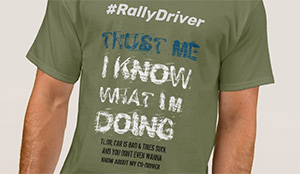Rally car as a daily driver?

Let’s say you have a rally car of some kind, it could be a top notch and capable rally machine, such as Mitsubishi Lancer Evo SomeNumber or Subaru Impreza, or a more tame yet very fast in proper hands car like Peugeot 206 or similar. We can also assume you just bought this car, maybe because you actually want to compete in it or maybe you just always wanted a rally car of your own. Believe it or not, some people would really like to have a car like that, just for the sake of owning one – maybe take it for a “walk” now and then or take part in some show events, but mainly to have a car properly set up just because they’re fans of the sport. To them such car would be like a large memorabilia, a souvenir or even a fetish. Regardless, you’ve added a rally car to your fleet and of course it’s properly registered and allowed to be used in everyday traffic. How tempted would you be to use such car as a daily driver? Would you even buy one for this sole purpose – to be your everyday car?
Admit it – idea is too good and tempting to ignore, despite many drawbacks of a rally car when compared to a proper daily driver road vehicle. The idea of feeling like a rally driver even if you’re just going to fetch few beers from the shop. The epic routine of climbing over the rollcage, flipping the switches, reaching for the harnesses and listen to the buckles cling against the bars, pushing the starter button, strapping the belts tightly… Oh, let’s not forget the juicy, tasty, never-gets-old engine noise, helped by the sport exhaust, waking everyone up in the 1 kilometer radius. Depending of the car, you might also be treated to a wonderful “blang” as you put the beast into gear. If the car has a more elaborate gearbox, you will soon hear the infamous whine of the competition ‘box. To complete this picture you would also need some rally slicks so they eliminate any hope of a in-car conversation with your passenger due to overwhelming noise. Are you having fun yet? It’s a tempting dream!
One important part of any rally car is its rollcage. The bars close to your head and legs/arms will usually be padded, but this padding is not enough to prevent nasty hits and bumps even if you don’t have an accident. When in a rally car you should be wearing helmet and HANS device – there are no airbags to provide you with extra protection in critical situations. Usually there is also no ABS, ESP and all other goodies we take for granted these days. Even if your dream rally car / daily driver is set up for gravel, meaning more travel and softer ride, unless it’s really radically soft you can expect extremely bumpy ride. And I really mean bumpy – things you don’t even notice on the road in your normal car will suddenly turn into very palpable obstacles in a rally vehicle. Your ordinary car will run over many things without you ever noticing, but if you attempt the same thing with a rally car you will find out what 5 milimeter thick tarmac patch really feels like when introduced to a stiff suspension. Seriously, unless you’re strapped in you can expect to literally fly out of your seat if wheels find their way to some of the most elaborate imperfections on the road. Stiff suspensions will kick and jerk and throw surprises at you – don’t leisurely hold a steering wheel with two fingers because it will break free from you. Also, steering in rally cars is much more direct. Be ready for mountain of information being forced into your hands thanks to stiff suspension and direct steering. It’s how rally drivers do their magic!
Rally cars are built for competition, but they’re also a tempting piece of tech, a wonderful way to suddenly become a rally (car) driver and make your dream come true. Unlike circuit race cars, many rally cars can be driven on public roads and that alone makes them even more desirable. Don’t worry, I did not forget the mandatory show-off factor – your neighbors maybe won’t mistake you for a real rally driver, but if you drive across the city and casually cruise around some unfamiliar neighborhoods, perhaps someone will take you for a motor sport ace.
Up to this point, it’s all nice and harmless, more or less. If you are aware of your car’s limitations and the lack of comfort, while also paying close attention to possible safety risks, I see no problem in driving rally cars a bit, moving some kidney stones and realigning bulged discs in your spine. Unless you try driving the car on public roads like you’re on special stages, I say drive them if you feel like it and/or have a rally car handy. Keep the rally speeds away from everyday roads unless they’re closed off and there is a starting number on car’s doors, your co-driver counting down the seconds before the stage start.



